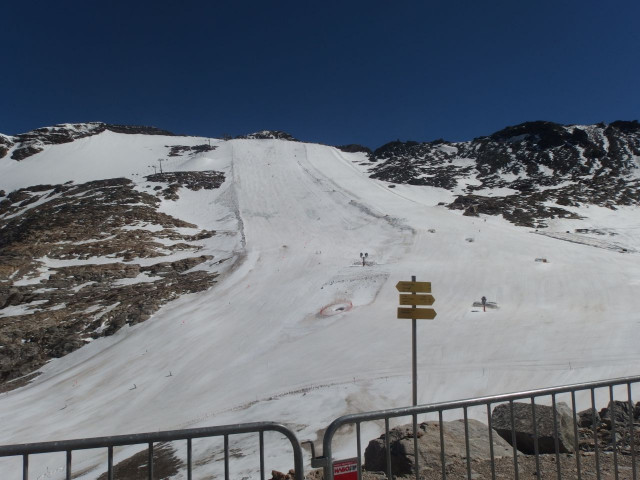Glacier Skiing in Times of Climate Change
Written by Leon Brüniger & Simon Pflugshaupt, students of the University of Zurich
Glacier skiing is a passion of many winter sports enthusiasts. They seek the thrill of skiing on top of these frozen giants and are often suspected of contributing to the glacier's gradual demise – the activity seems to become intricately tied to the health of the environment.
The relationship between glacier skiing and glaciers themselves is multifaceted. On one hand, glaciers constitute an economic opportunity for winter tourism. Possibly, glaciers could even benefit from sport activities. Yet, skiers are intruding into a vulnerable environment which is already under pressure due to warming temperatures. The following article aims at understanding a paradox, where one factor depends on the existence of the other (Haimayer 1989).
The complex relationship has already been examined and thereby, several positive and negative effects could be observed. Glaciologist Michele Koppes had a close look at a glacier in Whistler Blackcomb in British Columbia, CA, where skiing is quite popular. The area receives large amounts of black and brown carbon from the neighboring ocean. Such layers of dark sediment increase glacier melt by reducing the albedo. Skiing scrapes off these layers and reduces the melt rate. Simultaneously, the preparation of slopes and skiing itself leads to a compaction of upper snow and ice layers. This slows the snowmelt somewhat. "But the bigger issue at the Horstman Glacier specifically, is that they want to preserve the snow surface through the summer ski season" (Stern 2020).
Summer skiing is an activity closely intertwined with glacier skiing, as glaciers allow ski resorts to be open in summer. The use of glaciers for (summer) skiing is a fairly recent development. In Austria, for example, modern glacier skiing was introduced in the late 1960s (Haimayer 1989: 52). As glaciers were still advancing in the 1970s and 80s, there was a boom in the development of glacier ski resorts, which were sometimes built entirely on the glaciers themselves (Fischer et al. 2011: 89).
However, as the effects of climate change have become worse, the trend has changed. Environmental organisations now oppose the expansion of glacier skiing, seeing it as a threat to glaciers (Diolaiuti et al. 2006: 207). The effect of skiing on glacier health is not clear-cut; Fischer et. al (2011: 95) find no differences between exploited and non-exploited glaciers. Irrespective of human action, however, climate change has deeply changed glacier skiing. The record temperatures of recent summers have caused glacier ski resorts to drastically reduce summer opening days (Abegg & Mayer 2023: 1). As glaciers retreat faster than ever, infrastructure costs also skyrocket (Abegg & Mayer 2023: 5), as the foundations of the resorts literally melt away.
Overall, the future of glaciers seems to be the future of glacier skiing. As glaciers are melting, glacier skiing is losing popularity, with alpine tourists turning to other activities instead (Diolaiuti et al. 2006: 215) and the resorts following suit (Abegg and Mayer 2023: 7). Researchers are now estimating the remaining lifespan of glaciers (Diolaiuti et al. 2006: 215). That lifespan will determine the future of many ski resorts.
Literature:
Abegg, B., Mayer, M., (2023): The exceptional year of 2022: "deathblow" to glacier summer skiing in the Alps? Frontiers in Human Dynamics 5, pp. 1-7.
Diolaiuti, G., Smiraglia, C., Pelfini, M., Belò, M., Pavan, M., Vassena, G., (2006): The recent evolution of an Alpine glacier used for summer skiing (Vedretta Piana, Stelvio Pass, Italy). Cold Regions Science and Technology, 44, pp. 206–216. https://doi.org/10.1016/j.coldregions.2005.11.006.
Fischer, A., Olefs, M., Abermann, J., (2011): Glaciers, snow and ski tourism in Austria's changing climate. Annals of Glaciology, 52, pp. 89–96. https://doi.org/10.3189/172756411797252338.
Haimayer, P. (1989): Glacier-Skiing Areas in Austria: A Socio-Political Perspective. Mountain Research and Development, 9(1), pp. 51-58.
Stern, J. (2020): Is Skiing Good For The Health of Glaciers or Speeding Their Demise? Powder. URL: <https://www.powder.com/stories/is-skiing-good-for-glacier-health-or-speeding-their-demise>, Access: 26.11.2023.
Figure:
Wikimedia Commons (2016): Mölltaler Gletscher (01), URL: <https://commons.wikimedia.org/wiki/File:M%C3%B6lltaler_Gletscher_%2801%29.jpg>, Access: 26.11.2023.
Related Posts
Comments
By accepting you will be accessing a service provided by a third-party external to https://www.mountainapp.net/
This website uses no external trackers, no analytics, just session cookies and values your online privacy.



